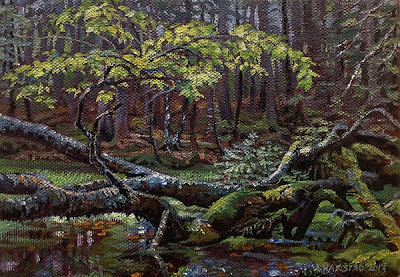Vernal Pool at Ayers Lake (oil on canvas 5 x 7 in.) Sold
Everywhere I looked there were different textures - nothing was like anything else, and the slower I walked,
the more I saw. It was if the forest magnified life, and immersed in it I became smaller and smaller, until I began to see mosses and lichens and mushrooms as if they had never been seen before - everything was fresh and surprising! Tiny purple mushrooms glowing like lavender lampshades sprouting from the mossy coat on a tree trunk, and sharp little spikes pointing outward from the upturned tips of a pale, braided-looking moss. Farther underneath each of these moss branches I found spore-bearing structures hanging downward like tiny orange cowbells.
the more I saw. It was if the forest magnified life, and immersed in it I became smaller and smaller, until I began to see mosses and lichens and mushrooms as if they had never been seen before - everything was fresh and surprising! Tiny purple mushrooms glowing like lavender lampshades sprouting from the mossy coat on a tree trunk, and sharp little spikes pointing outward from the upturned tips of a pale, braided-looking moss. Farther underneath each of these moss branches I found spore-bearing structures hanging downward like tiny orange cowbells.
A vernal pool hides like a black diamond set in the most vivid green sphagnum moss I've ever seen. Across the pool leans a living Yellow Birch, a branch of which arches like a Bonsai tree, back toward the mossy sculpture of its roots and dead branches, elegance reflected in the eye of the forest. Here is where I stopped to paint.
When we reached the lake, the heart of this ancient and venerable forest, the king and queen approached - the Ayers Lake resident Loons, gliding on their reflections to see who had come. The wide space of the lake revealed the forest in a different light, and like our view from the lookout before we'd entered it, we could see the texture of old growth - the dark mossy patches of ancient Hemlock and Red Spruce, and the standing dead trees that still play their part in the life of the forest.
Ursula LeGuin wrote a little book called "The Word For World is Forest". When I think of this, I'm painfully aware of how small a portion of the once great forests of New Brunswick are left whole. Some of the never logged forests around Ayers Lake are slated to be logged this summer. If this is done, the delicate and diverse life that require centuries to establish its deep interconnectedness will be crushed by machinery, and some species (perhaps some not yet known to science) will never return. Trees would grow here, but the entire fauna and flora unique to this place would never be the same. The human spirit needs that sense of stability and ancient continuity. Climax forests like this help to slow climate change, and even changes that happen around it are buffered within it by the great and complex sponge of living diversity.
Even if I never return to Ayers Lake, it will be important for me to know that it exists, and that any change that happens will the kind of change that takes centuries.
Fred wrote this to the New Brunswick NatureList after our visit to Ayers Lake: "Over the past two decades in eastern Ontario, the whole forestry and naturalist community has been engaged in the quest to find and protect remnants and scraps of oldgrowth forests that chance and circumstance had preserved in private hands from clearing and grazing. Such stands maintained not only the forest trees, but the understory and forest floor plants, Fungi, lichens, Salamanders, and invertebrates which make up a mature forest ecosystem. Most of the forest biota cannot survive conventional logging, and, if forestry is to have any hope of being sustainable, substantial reserves of mature forest, dispersed across the landscape, are required to provide for the recolonization of disturbed sites.
"As the remnants of oldgrowth we have in eastern Ontario are discovered and mapped, they're protected by national or provincial parks, or by the Nature Conservancy, land trusts, or Conservation Authorities. At Ayers Lake it was wonderful to see a great variety of these species of mature forest in a relatively undisturbed forest over a fairly large area, and very encouraging to see this diversity recognized as a "unique area," though it was discouraging to hear how little survey work had been done there, and how poorly the area's evident biological diversity was documented.
"For four summers now, we've been participating, with biologists from all across North America, in the New Brunswick Museum's biological inventories of New Brunswick's Protected Natural Areas, and we hope Ayers Lake, regarded as the largest remnant of southern New Brunswick's oldgrowth, can be added to the list of protected areas that can be surveyed in this way."





This is LOVELY, Aleta!
ReplyDeleteBeautiful. I can feel all the deep, rich textures. Thanks for "taking me there" through your painting.
ReplyDeleteThis painting has my heart beating. It is so alive and vibrant. In this piece, I can feel what you are writing about...Jackie Madill
ReplyDeleteBeautiful painting and wonderful story. Thank you for taking me there. Hoping that the area can be conserved. Rae Smith, Australia.
ReplyDeleteRecent news isn't good - the owner of the property, the powerful New Brunswick company J. C. Irving has put in new roads preparatory to begin logging, perhaps this fall. We're trying to find out if there's anything anyone can do. Their lawyers are powerful and are experienced in suing people who try to tell them what not to do with their own land. The Nature Conservancy of Canada would like to purchase it, but at what price?
ReplyDelete